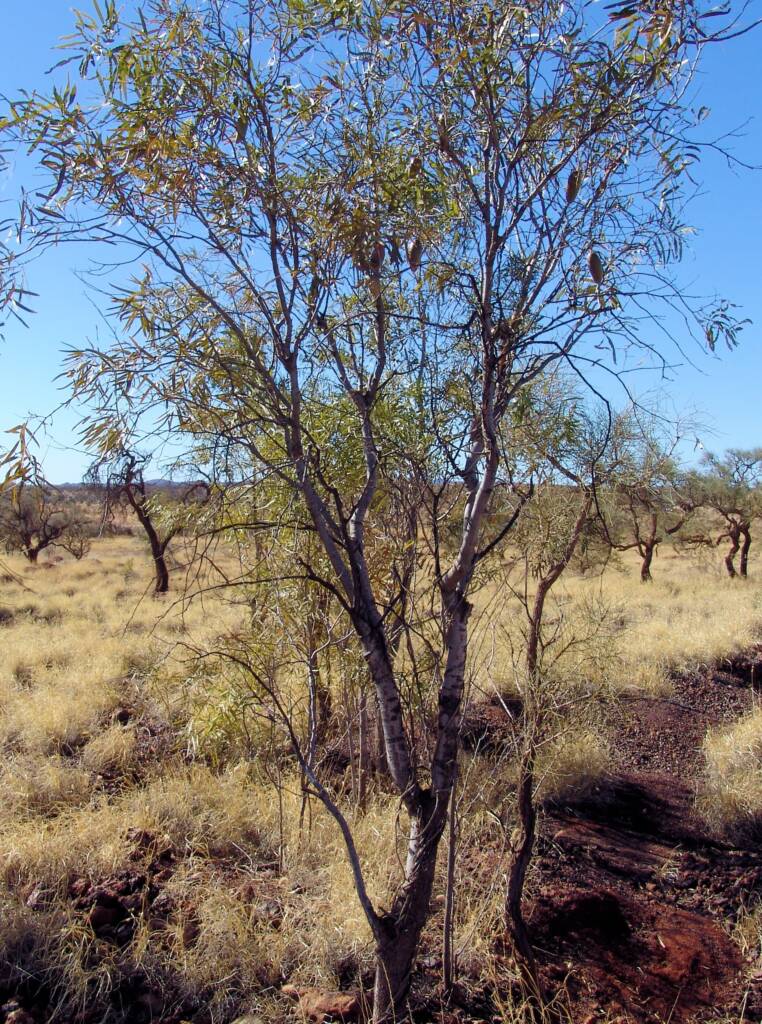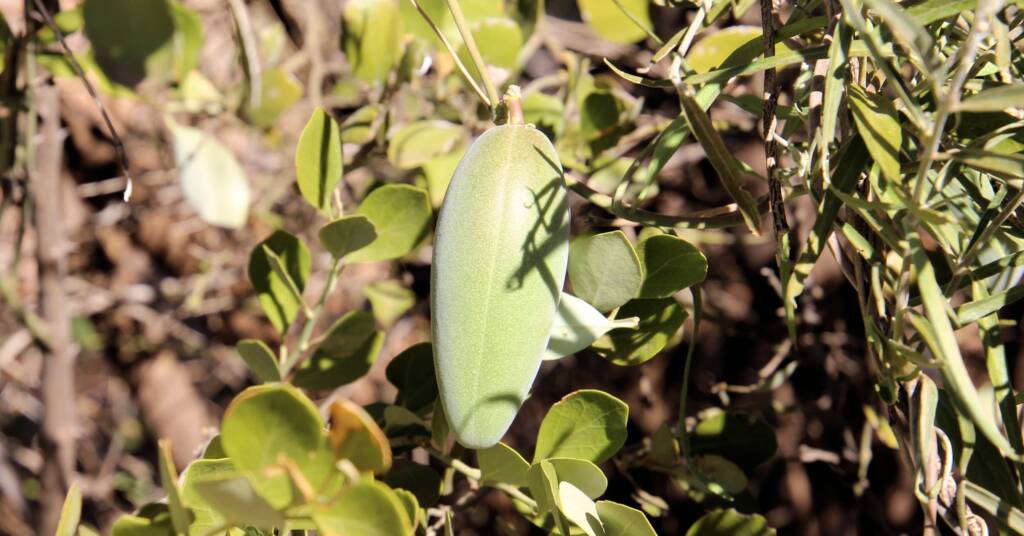Flora & FaunaFauna Flora Fauna Flora Funga Glossary Funga Related Topics Scientific Classification Backyard Wildlife Floral Emblems of Australia Wildflowers
Related link:
Bush Food – Indigenous Australia – Iconography and Symbols
Bush Banana – Aboriginal Symbols / Bush Food
Bush Banana (Marsdenia australis) – known as langkwe in the Eastern Arrernte language.

The bush banana is a climbing woody vine found growing on other shrubs and trees, and often difficult to see among the trees own leaves. It has been seen growing over acacia, red mulga, native orange, corkwood hakea and a cassia.
The bush banana has creamy, yellowish flowers (tipped with green as flower buds), and thick narrow leaves that grow from a short stalk. The fruiting pod is pear-shaped, hence its other common names of Native pear, Silky pear.
- Common Name
- Bush banana, Doubah, Native pear, Silky pear, Green vine.
- Where Found
- Found in Western Australia, South Australia and throughout Central Australia.
An important Aboriginal food, whilst all parts of the bush banana plant are eaten, the sweet flower and young fruits are eaten raw, being the most favoured parts of the plant. The young seeds taste like a crunchy sweet pea. The seeds can also be lightly roasted for consumption. When the pods matures, it consists mainly of bitter seeds and their plumes. The seeds are discarded and only the thick outer rind eaten. The shoots and young leaves are also eaten, whilst the older leaves are eaten after being steamed. Even the roots are eaten during times of food shortage. The only parts not eaten are the woody stems and fine roots.

The Bush Banana is a totemic plant that often features in Aboriginal mythology and can be found in many Aboriginal paintings.
The plant was originally named ‘Leichhardtia australis’ as referenced in the Wildflowers & Plants of Inland Australia by Anne Urban. Its current name ‘Marsdenia australis’, with ‘Marsdenia’ named after William Marsden (1754-1836), the Irish orientalist and numismatist and ‘australis’ comes from the Latin meaning ‘southern’.
WARNING: Extreme care must be taken when identifying edible food plants and those used in bush medicine. Some bush foods are only edible at different stages of the plant cycle, or when treated appropriately. Bush medicine should only be used under the guidance of a qualified physician. Information here is only provided for research. You should always seek experts in the field to confirm the identification of the plant and whether they are edible or appropriate.
- Scientific classification
- Kingdom: Plantae
- Phylum: Charophyta
- Class: Equisetopsida
- Subclass: Magnoliidae
- Superorder: Asteranae
- Order: Gentianales
- Family: Apocynaceae
- Genus: Marsdenia
- Species: M. australis
- Binomial name: Marsdenia australis
FloraFlora in Australia Flora Index Acacia Anigozanthos (Kangaroo Paws) Annual Yellowtop Apium prostratum subsp. prostratum var filiforme Apple Bush (Pterocaulon sphacelatum) Australian Bluebell Australian Gossypium Banksia Batswing Coral Tree Billy Buttons Birdsville Indigo Blue Pincushion Bush Banana Callistemon Callitris drummondii (Drummond’s Cypress Pine) Calothamnus quadrifidus Cape Honeysuckle Cassia fistula (Golden Shower) Cattle Bush Common Heath Crotalaria Darwinia wittwerorum (Wittwer’s Mountain Bell) Daviesia oppositifolia (Rattle-pea) Desert Oaks Drumsticks Eremophila Eucalyptus Ficus Flannel Cudweed (Actinobole uliginosum) Georges Indigo Goatshead Burr (Sclerolaena bicornis) Golden Everlasting Goodenia Gossypium Grass and Grasses Grass Trees Grevillea Grey Germander Hakea Kapok Bush (Aerva javanica) Lambertia sp Leptospermum MacDonnell Ranges Cycad Maireana scleroptera Mexican Poppy Minnie Daisy Mistletoe Family Nardoo Native Apricot Nicotiana megalosiphon subspecies sessilifolia Nuytsia floribunda Orange Spade Flower Orchidaceae Parakeelyas (Calandrinia) Pebble Bush (Stylobasium spathulatum) Perennial Yellow Top Pink Everlasting Pink Rock Wort Poached Egg Daisy Portulaca Proteaceae Ptilotus Quandong Resurrection Fern Rosy Dock Ruby Saltbush Santalum Solanum Spike Centaury Spinifex Storkbill (Erodum cygnorum) Striped Mint Bush Sturt’s Desert Pea Sturt’s Desert Rose Tall Saltbush Tangled Leschenaultia Tar Vine Tribulus eichlerianus Upside-down Plant Urodon dasyphylla Variable Daisy Waratah (Telopea) Wertabona Daisy White Cedar (Melia azedarach) White Indigo White Paper Daisy Wild Passionfruit Wild Stock Woolly-Headed Burr Daisy Woolly Bush Yellow-keeled Swainsona
Flora & FaunaFauna Flora Fauna Flora Funga Glossary Funga Related Topics Scientific Classification Backyard Wildlife Floral Emblems of Australia Wildflowers











